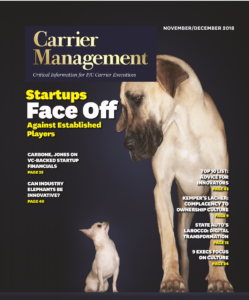

“You don’t have to be the CEO and get invited to deliver keynote speeches in order to influence the way an industry thinks.”
Adrian Jones, deputy CEO of SCOR P&C Partners and one of the guest editors for the Nov/Dec edition of Carrier Management, shared his views on the power of social media and the success he and co-editor Matteo Carbone have had influencing conversation about insurance over the past year.
Carbone, who is also founder and director of the IoT Insurance Conservatory, teamed up with Jones in March to start writing a series of articles about the statutory financial results of InsurTechs Lemonade, Root and Metromile. Both have separately published articles about InsurTech and innovation trends as well, posting them all on LinkedIn.
“Even 10 years ago, if I had written an analysis in my spare time, perhaps I would email it around and maybe a few dozen people would read it. Today, you put it on social media, and publications like Carrier Management pick it up, and suddenly it’s getting tens of thousands of views and really starting to influence the conversation.
“The democratization of voices that’s been enabled by technology is a fundamentally good thing,” Jones told us. “I hope that that’s encouraging to young people who are looking at this industry and deciding what their place in it might be,” he added.
The depth of the financial analysis is admirable. So, why publish it for everyone to see? Isn’t information an advantage to be held onto?
Jones revealed a positive outcome. “I recently posted a job ad on LinkedIn…and within a week that posting had 20,000 views. And we got scores of good applicants out of that within a week, speeding our process and potentially saving external recruitment fees. In other words, being active on social media can draw talent, which has a real bottom-line impact. The impact may show up in unexpected places.”
In short, there is value in sharing the information about InsurTech innovation. There is also value in embarking on innovation journeys for property/casualty insurers. Talk about pursuing innovation initiatives in the insurance industry raises its own set of questions. Why should industry professionals devote time away from their regular jobs to such efforts? Why should carriers incur costs and devote resources to efforts that might fail?

Interested in receiving Carrier Management magazine? Click here.
Jones and Carbone tackle such questions head on, serving as the guest editors for the “Innovation and Strategy” features of this edition. Witness the waterfall chart included in an article that Carbone co-authored about a world in which insurers touch delighted customers by putting the Internet of Things to work for them. Or read his arguments about how insurance telematics best practices globally have generated more value through claim cost reduction and changes in driver behavior. Step by step, Carbone walks readers through the costs and then the value to be derived from innovation.
With the value question resolved, both authors also help readers understand how to get innovation moving within the walls of big, established insurance companies—industry elephants, as Carbone calls them at one point. Jones addresses innovative young individuals like him who want to move mountains but need to focus instead on “one big thing a year” and “learn how and when to fight,” among other things. Carbone addresses the leaders of carrier organizations with advice for attacking innovation myths to build or mature their innovation practices.
Separately, this edition dives into the topic of corporate culture, with executives sharing perspectives on cultural transformations and evolutions at their firms.